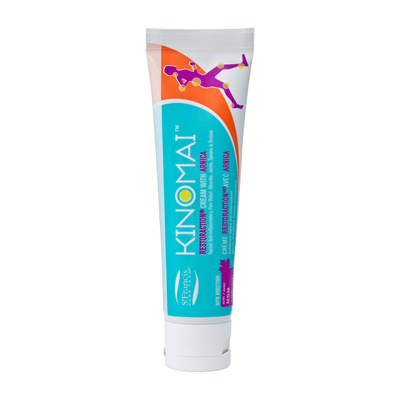Already have an account? Sign in

Restoraction® Cream is the ideal first aid salve, great for relieving the aches and pains associated with sore, stiff muscles. It produces effective anti-inflammatory action, improving circulation, dispersing congestion and clearing the heat from injured tissue.
The following is a brief explanation of the individual ingredients and the rationale for their use:
Arnica – Renowned herbalist David Hoffmann explains that, "arnica provides us with one of the best external remedies for local healing, and may be considered a specific when it comes to the treatment of bruises and sprains... The herb itself, used externally, will help relieve pain and inflammation of phlebitis, rheumatism, and similar conditions."
MSM – A naturally occurring substance first discovered in 1940, MSM has astonishing analgesic and anti-inflammatory properties. MSM also improves blood flow and reduces muscle spasms. Topically, MSM and its precursor, DMSO, aid the penetration of the skin, acting as carriers for other herb or drug ingredients.
Lobelia – As classic British herbalist, Mrs. Grieve, points out, traditionally lobelia has been used as a local application for sprains, bruises, and skin diseases.
Horse chestnut – The World Health Organization (WHO) monograph on horse chestnut confirms the topical "uses supported by clinical data" as being bruises and sprains, and adds that it can be used for symptomatic treatment of chronic venous insufficiency.
Comfrey – This product contains comfrey leaf, which has a much lower alkaloid content than does the root. The British Herbal Pharmacopoeia, a normative authority, describes the properties of the leaf as vulnerary, anti-inflammatory and anti-rheumatic, adding that it can be used topically for bruises and sprains.
Witch hazel - The WHO monograph on witch hazel lists the uses for this herb that are supported by clinical data. These include bruises and sprains, local skin inflammations, hemorrhoids and varicose veins.
Elder flowers – David Hoffmann praises the elder tree, with all its wonderful uses, as "a medicine chest in its own right". Mrs. Grieve remarks that, "Externally, Elder Flowers are used in fomentations, to ease pain and abate inflammation... A good ointment is also prepared from the flowers by infusion in warm lard, useful for dressing wounds, burns and scalds... Elder Flower Ointment... is an old remedy for chapped hands and chilblains."
Calendula flowers - Eclectic physician Finley Ellingwood, M.D. extols calendula: "As arnica is applied to bruises and sprains, this agent is also applicable; and in addition it is of much service applied to recent wounds, cuts and open soresÉ It relieves the pain in wounds, and if there are not bad bruises, it quickly relieves the soreness and favours the healing process."
St. John’s wort - From as early as the first century A.D., documents reveal that St. John’s wort flowers infused in olive oil were used for burns, haemorrhoids, and skin injuries. Eclectic physicians like HW Felter M.D. prescribed St. John’s wort oil to treat bruises, contusions, sprains, lacerations, swellings, and ecchymoses (bruises). He writes that, "St. John's Wort is valued by many practitioners as a vulnerary, much as arnica is employed." Herbalist David Hoffmann praises St. John’s wort as "a valuable healing and anti-inflammatory remedy." He emphasizes that the externally applied oil speeds the healing of wounds, burns, bruises and varicose veins and adds that, "The oil is especially useful for the healing of sunburn."
Turmeric – Turmeric has been used traditionally in Indian Ayurvedic medicine as an external application for inflammations and for traumatic injuries to joints and muscles.
African cayenne – The British Herbal Pharmacopoeia points out that this herb has counter-irritant and rubefacient properties, adding that the fruits can be used topically for neuralgia, rheumatic pains and chilblains. Rubefacients increase the blood circulation to an area, thereby speeding the healing process.
The following essential oils work hand in hand with arnica’s wound-healing and anti-inflammatory properties:marjoram (analgesic and antiseptic), juniper (for wounds and skin conditions), ginger (for muscle aches and pains, along with bruises and sores), and turmeric (for sprains, bruises, wounds, joint inflammation).
Aloe vera – Aloe vera has well-verified wound healing properties. Moisturizing and emollient, this herb contributes immune-enhancing, antibacterial, analgesic, and anti-inflammatory qualities to the formula.
The following homeopathic ingredients were chosen to complement the analgesic, wound-healing, and anti-inflammatory properties of the other ingredients: Apis (for swelling and burning pains), Arnica (for traumatic injuries), Bellis perennis (aid to wound healing), Bryonia (for inflammatory pains), Calendula (for antisepsis and wound healing), Hamamelis (for reducing swelling and bruises), Hypericum (for nerve pains), Ledum (for arthritis inflammation and injuries to joints), Rhus-tox (for arthritis inflammation and joint injuries), Ruta (for injuries to joints and tendons), Sulphuricum acidum (for bruising), and Symphytum (a wound healer especially for injuries to joints, bones and periosteum).
Combination rationale: With its creatively formulated range of synergetic ingredients, this is, quite simply, one of the best natural creams on the market.
Administration: Apply cream topically as needed to affected area of skin up to 5 or 6 times daily.
Supplement Facts
ackage For Directions
It looks like there are no similar
products available
